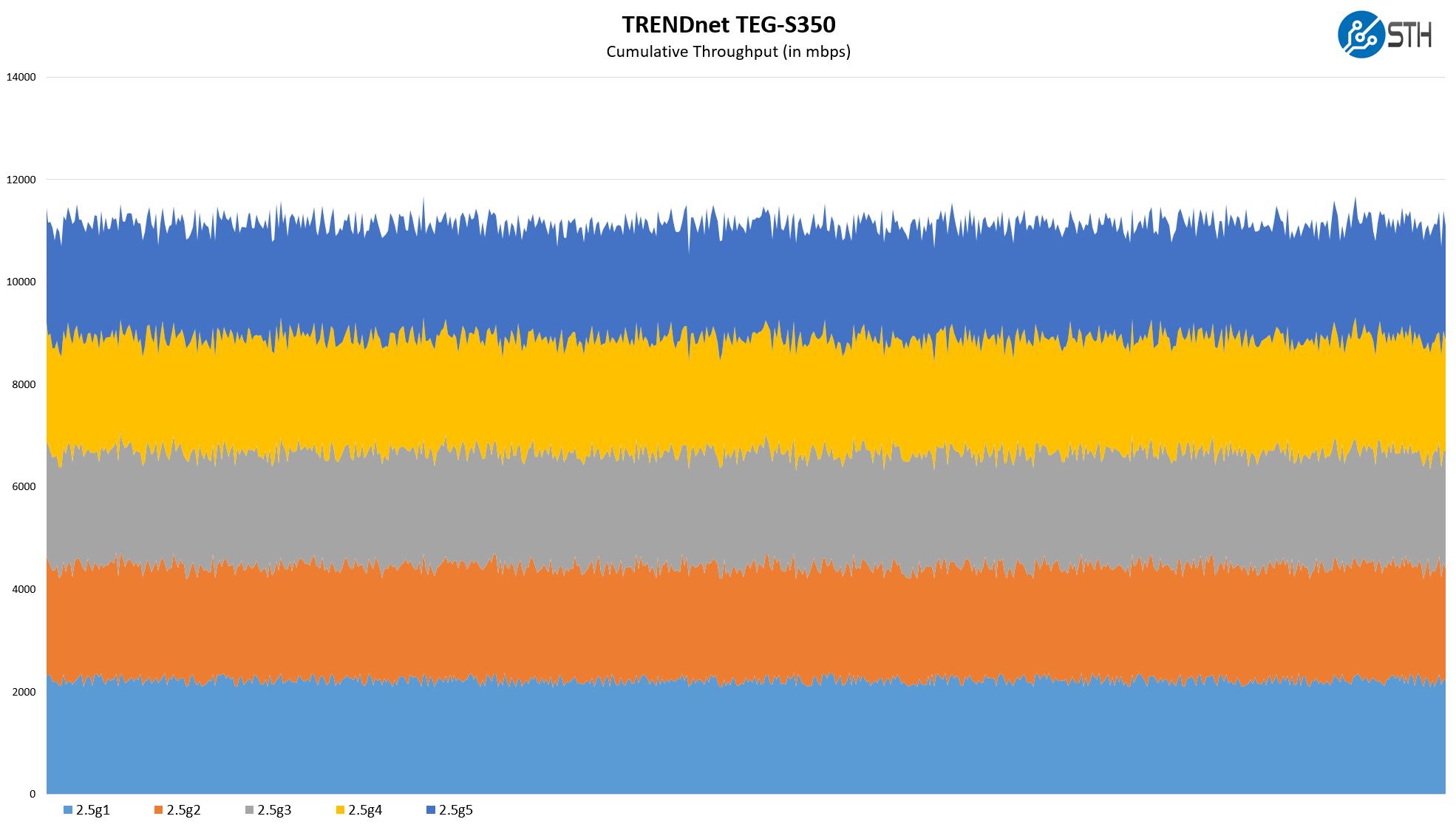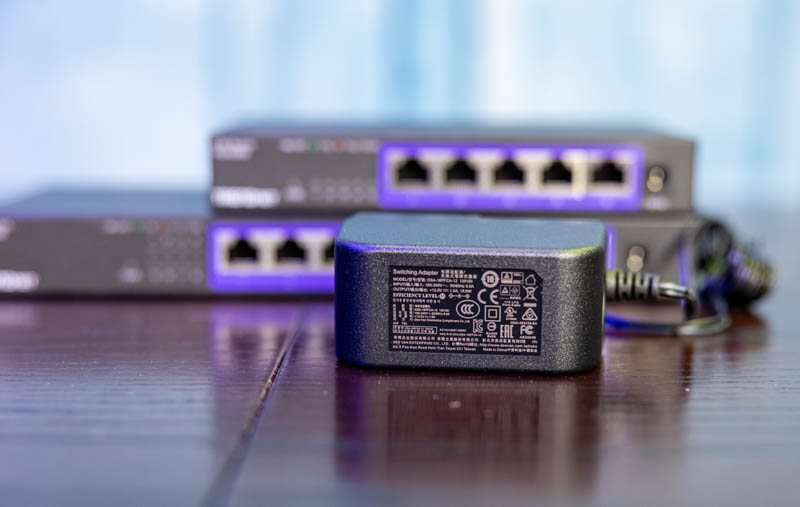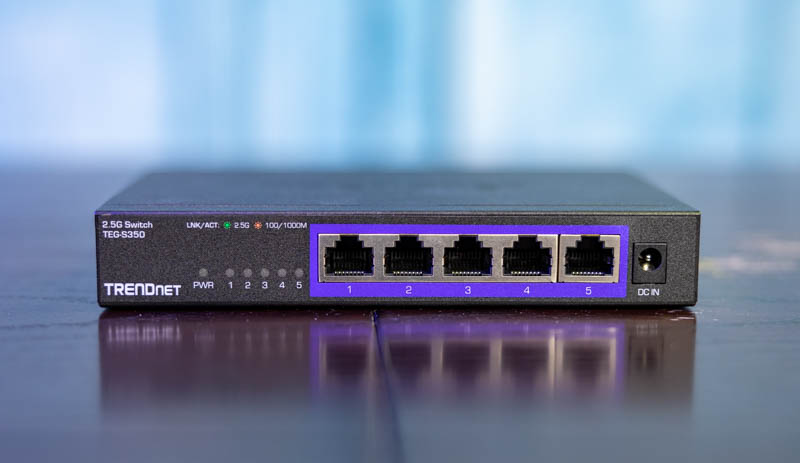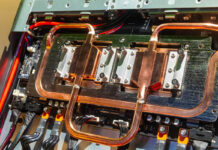TRENDnet TEG-S350 Performance
Unmanaged switches are not necessarily the most interesting components of the switching ecosystem. Still, we wanted to quickly take a look at performance.

The switch itself was able to get 2.5GbE traffic on each of the ports which is what we expected.
We normally would discuss management, however, this is an unmanaged switch so that limits options to discuss a feature that does not exist. Unmanaged switches have been around for a long time, and so we are going to assume our readers understand the implications of an unmanaged switch. Instead, we are next going to focus on power consumption.
TRENDnet TEG-S350 Power Consumption
In terms of power, the TEG-S350 uses an external 18W DC power adapter. This is shared between the TEG-S380 8-port switch and the TEG-S350 5-port switch:

We saw around 3-4W at idle and the switch has a maximum power consumption of 8-10W. Those are not huge figures, but we simply wanted to present our findings. For our readers thinking about using this switch for a WiFi 6/ WiFi 6E infrastructure, this is not a PoE capable switch.
TRENDnet TEG-S350 Pricing and Market Impact
In unmanaged switches, pricing is perhaps not everything, but it is clearly one of the biggest factors. For the TEG-S350, this is a doubly important aspect since there is competition with other 2.5GbE switches as well as 1GbE infrastructure. Let us start with the list pricing:

Here we can see that this switch is $189.99 or $23.75 per port. The interesting aspect here is that the incremental three ports are effectively half-price over the per-port cost on the 5-port unit.
We used Amazon and a quick web search for street pricing and this is what we found at the time of writing this review (pricing may change over time this is as of April 2, 2021 that we are using for both reviews as our pricing point):

The per-port cost goes down by $1.25 due to the $10 lower street price than the MSRP. Here is an Amazon affiliate link that will pull current pricing:
We decided that we would use April 2, 2021 pricing to make the comparisons since we knew this would be reviewed in the future. The current Amazon pricing a month later is $125 which lowers the per-port cost by another $3 on this model, but it is still higher than the TEG-S380.
Just discussing some comparison points here:
- QNAP has a 5-port unmanaged switch (QSW-1105-5T) that was around $189 a month ago but is $109 a month later. That presents a lot of competition here.
- TP-Link has a $139.99 5-port switch, the TL-SG105-M2 which is similar in price to the TEG-S350. That was April 2, 2021 pricing. Currently, this is a $110 switch on Amazon which makes it around $15 or $3/ port cheaper than the TRENDnet unit.
Again, in this $125 range, it is competing against many sub-$20 1GbE 5-port switches. We think that TRENDnet needs to drop pricing down to that $108-110 level to be competitive with other offerings. This is basically the price of a competitive 5-port 2.5GbE switch plus a 5-port 1GbE switch.
Our general sense is that the low port count and relatively high cost still make this unit harder to recommend compared to alternatives.
Final Words
On one hand, this switch is lower cost due to its lower port count, as well as prices dropping over the past month. On the other hand, it is harder to recommend given its premium pricing.

Generally, we think that this switch has too much of a premium over competitive offerings in the 2.5GbE space, but also when compared to 1GbE switches. It worked fine in our testing, and functionally it did what we expected. This is simply the challenge of pricing. We will also note that many of our readers after publishing the 8-port review expressed that they think the pricing for 2.5GbE transition is closer to $10/ port not $25/ port. Another way to think of this is that we have seen a greater than 10% price drop in a month, so pricing seems to be heading in the right direction.




In my personal opinion 2.5G switches either have to move much closer to 1G switch pricing, or they should add features like 10G uplinks to justify the premium.
Right now the Zyxel XGS-1010-12 with its combination of 8x1G, 2×2.5G and 2x10G (SFP+) ports at $149 and €149 is a much more attractive option for my use case, but I’m really wishing that switches with more 2.5G ports come down in price. The QNAP QSW-M2108-2C has a nice set of ports at 8×2.5G and 2x10G (combo RJ45/SFP+), but the price is currently just above $/€ 300.
Do all the ports go to 1GB if 1 GB line is plugged in. I would have thought that this would be tested since people are going to be upgrading existing systems.
@Robert Edward Bridges
Just like your 1gbe switch doesn’t become a 100M switch just because a 100M device is attached, there’s no reason for this 2.5gbe switch to degrade based on what is attached to what port.
Switches displaced hubs on the fact that each port has effectively it’s own dedicated bandwidth in both directions. So a 5-port 2.5gbe switch has (should have) a fabric capable of concurrently handling at least 25gbps (which is what traffic it would be carrying if every connected device was operating at the maximum possible rate in both transmit and receive directions) — that means that each port has it’s own dedicated bandwidth and can operate independently of the other ports.
Read the specs of the switch: https://www.trendnet.com/support/support-detail.asp?prod=100_TEG-S350
I have the QNAP QSW-M2108-2S, while it does work very well power consumption is 12watt with no network cables connected and 16watt with 3 devices connected (max 24watt).
This is a lot more than my D-Link gigabit switches (which are rackmount and do have a builtin power supply).
I don’t think it’s a great option if you’re not using the 10G ports.
The newer revision (v2.0r) of this switch, which I bought for about 77 USD, is more power efficient on idle than V1.0R. (I measure 1.0W with nothing plugged in, and marginal power draw of <1 W per additional idle connection, depending on what is on the other end. I don't have the setup to do proper load testing.) The new version also the link indicator lights on the opposite side of the one with the ports.